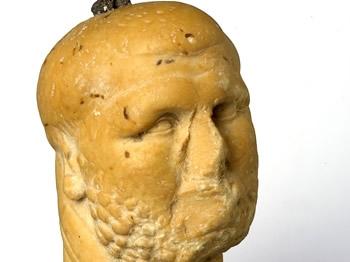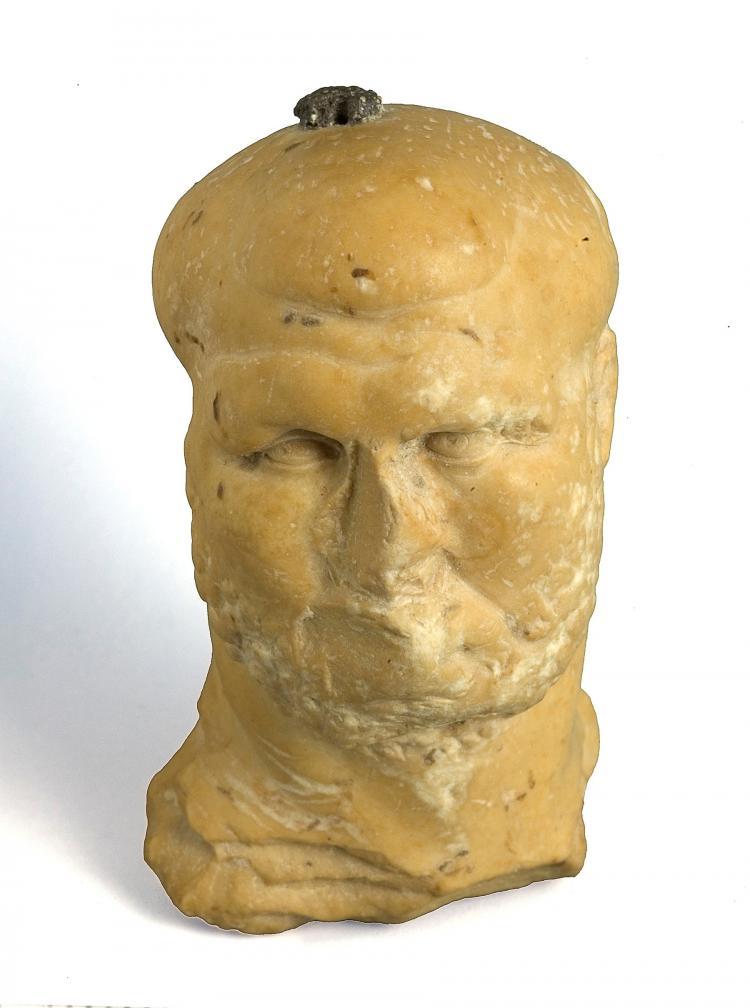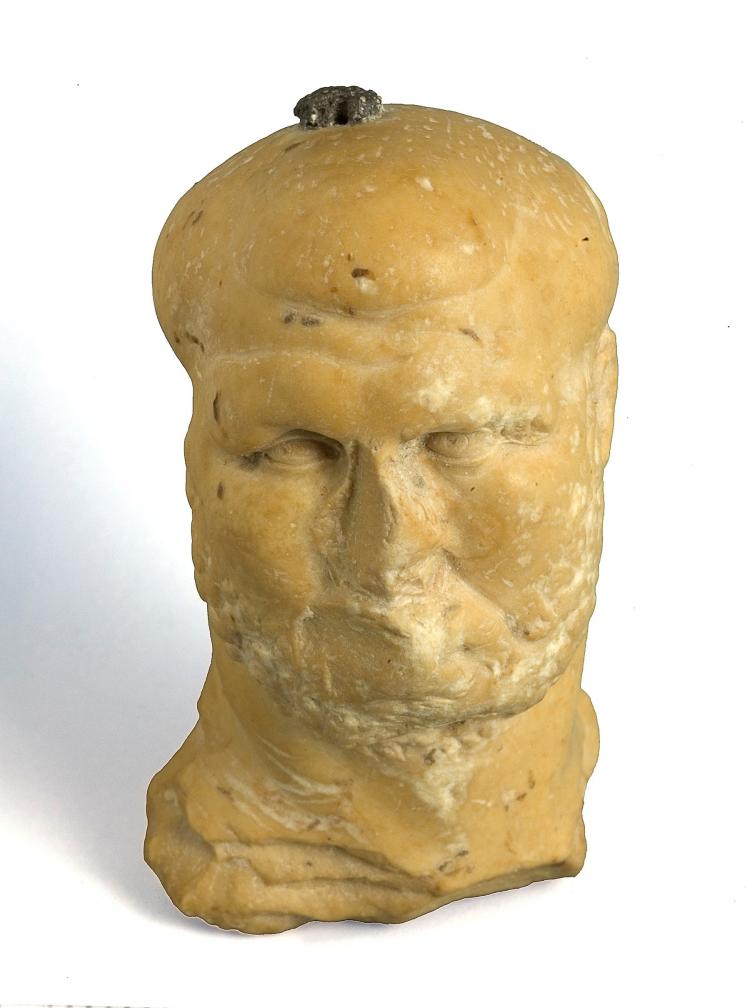An ancient and unusual figurine bust made of marble and depicting a miniature image of a bearded man’s head has been discovered in Israel. The figurine, believed to be 1,800 years old, was found in an excavation the Israel Antiquities Authority is conducting in the area of the Givati car park in the City of David, in the Walls around Jerusalem National Park.
According to Dr. Doron Ben-Ami and Yana Tchekhanovets, directors of the site excavation, the high level of finish on the figurine is extraordinary, and it meticulously adheres to the tiniest of details.
The man depicted in the bust has a short curly beard, and its head is slightly inclined to the right. Both details are indicative of Greek-influenced work and dates it around the second or third centuries, considered a zenith of Roman sculpture. The marble is also of a pale yellow shade, which indicates raw material from an eastern origin. The exact origin of the materials is being investigated.
The stylistic motifs that are manifested in the image, such as its short hairstyle, the prominent lobes and curves of the ears, as well as the almond-shaped eyes suggest that the object most likely portrays an athlete, probably a boxer. Boxing was one of the most popular fields of heavy athletics in Roman culture and more than once Roman authors mention the demand by the Roman public in general, and the elite in particular, for boxing matches. Besides the prestige and the substantial amounts of money the victors of boxing competitions won, they were also afforded the support of the emperor himself, as in the famous case of Melancomas who was Titus’ favorite boxer.
Dr. Ben-Ami and Tchekhanovets believe the finding is unique. They say no similar artifact made of marble (or any other kind of stone) bearing the same image has been discovered in excavations elsewhere in the country.
A few similar artifacts that were made of cast bronze were discovered at different sites in the country and they have been found in large numbers in different places throughout the Roman Empire where the overwhelming majority of them date to the third century (the Roman period).
According to the researchers the two tiny holes that were drilled in its nape and which contained the remains of metal that was inserted in them indicate that this is a suspended weight that was used with hanging scales that are characteristic of the Roman period. Miniature bronze images of athletes, philosophers, satyrs and others were among the most popular of the suspended weights that were used in the regions that were under the control of the Roman Empire--from Pompeii to Sepphoris.
How did the Roman marble image get to the City of David? The marble weight likely belonged to a family of merchants who originally came from somewhere in the eastern part of the Roman Empire. Being a precious object the weight was passed down from generation to generation in the family until sometime in the fourth-fifth century CE when an unidentified merchant was stayed in the public building which is currently being uncovered in the Givati car park in the City of David. A very severe earthquake destroyed the building. While excavating the building the marble image was discovered amongst its ruins which constitute silent testimony of the drama that occurred in this impressive structure prior to its collapse.
Not long ago one of the largest and most impressive coin hoards ever found in Jerusalem was discovered at this site. It consists of 264 gold coins and was found at about the same time as a gold earring, inlaid with expensive pearls and remarkably well preserved, was also uncovered at the site.
According to Dr. Doron Ben-Ami and Yana Tchekhanovets, directors of the site excavation, the high level of finish on the figurine is extraordinary, and it meticulously adheres to the tiniest of details.
The man depicted in the bust has a short curly beard, and its head is slightly inclined to the right. Both details are indicative of Greek-influenced work and dates it around the second or third centuries, considered a zenith of Roman sculpture. The marble is also of a pale yellow shade, which indicates raw material from an eastern origin. The exact origin of the materials is being investigated.
The stylistic motifs that are manifested in the image, such as its short hairstyle, the prominent lobes and curves of the ears, as well as the almond-shaped eyes suggest that the object most likely portrays an athlete, probably a boxer. Boxing was one of the most popular fields of heavy athletics in Roman culture and more than once Roman authors mention the demand by the Roman public in general, and the elite in particular, for boxing matches. Besides the prestige and the substantial amounts of money the victors of boxing competitions won, they were also afforded the support of the emperor himself, as in the famous case of Melancomas who was Titus’ favorite boxer.
Dr. Ben-Ami and Tchekhanovets believe the finding is unique. They say no similar artifact made of marble (or any other kind of stone) bearing the same image has been discovered in excavations elsewhere in the country.
A few similar artifacts that were made of cast bronze were discovered at different sites in the country and they have been found in large numbers in different places throughout the Roman Empire where the overwhelming majority of them date to the third century (the Roman period).
According to the researchers the two tiny holes that were drilled in its nape and which contained the remains of metal that was inserted in them indicate that this is a suspended weight that was used with hanging scales that are characteristic of the Roman period. Miniature bronze images of athletes, philosophers, satyrs and others were among the most popular of the suspended weights that were used in the regions that were under the control of the Roman Empire--from Pompeii to Sepphoris.
How did the Roman marble image get to the City of David? The marble weight likely belonged to a family of merchants who originally came from somewhere in the eastern part of the Roman Empire. Being a precious object the weight was passed down from generation to generation in the family until sometime in the fourth-fifth century CE when an unidentified merchant was stayed in the public building which is currently being uncovered in the Givati car park in the City of David. A very severe earthquake destroyed the building. While excavating the building the marble image was discovered amongst its ruins which constitute silent testimony of the drama that occurred in this impressive structure prior to its collapse.
Not long ago one of the largest and most impressive coin hoards ever found in Jerusalem was discovered at this site. It consists of 264 gold coins and was found at about the same time as a gold earring, inlaid with expensive pearls and remarkably well preserved, was also uncovered at the site.







Friends Read Free